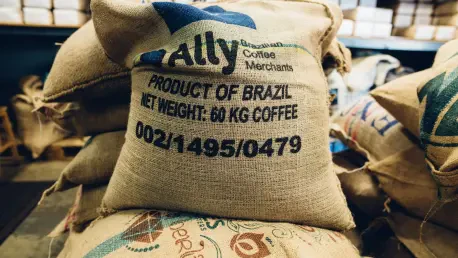In a landscape marked by persistent challenges, the Australian food and beverage manufacturing sector appears to be finding its footing after years of upheaval from global disruptions like pandemics, geopolitical tensions, and extreme weather events. Recent data paints a picture of cautious recovery, with producers navigating a complex web of supply chain issues, fluctuating costs, and shifting consumer demands. This intricate balance between resilience and vulnerability raises critical questions about whether stability is truly within reach for an industry vital to both the national economy and everyday life. As manufacturers adapt to a volatile trade environment, the latest insights from a comprehensive industry report reveal a sector at a crossroads, showing signs of rebound while grappling with ongoing pressures that could shape its trajectory for years to come.
Industry Trends and Recovery Signals
Excess Stock Rebound and Inventory Strategies
The food and beverage manufacturing sector in Australia has witnessed a striking shift in excess stock levels, signaling a move toward replenishment after a period of significant scarcity. Beverage producers, in particular, reported a nearly 50% quarter-on-quarter increase in excess stock during the latest reporting period, though the rise is more modest at 12% when compared to the same period last year. Food producers, meanwhile, saw a dramatic jump from $30,000 to $150,000 in excess stock over consecutive quarters. Across the broader manufacturing landscape, excess stock reached an average of $98,000, marking a nearly threefold increase from the prior quarter. While this surge might raise eyebrows, it remains below thresholds that would trigger widespread alarm. Instead, it reflects a deliberate pivot to more cautious inventory management, driven by the need to buffer against lengthening global supply chains and unpredictable trade conditions that continue to test the industry’s adaptability.
This trend toward stockpiling is not without its nuances, as manufacturers balance the risks of overstocking against the persistent threat of shortages. The sharp rise in excess inventory suggests a strategic response to recent disruptions, with companies prioritizing security over the lean operations that dominated in more stable times. For food and beverage producers, this approach is particularly critical given the perishable nature of their goods and the tight timelines they must navigate. While the current levels are manageable, there is an underlying concern about potential waste or financial strain if demand forecasts falter. The data indicates a sector learning from past volatility, opting for preparedness even as it treads carefully to avoid the pitfalls of excess. This cautious recalibration underscores a broader effort to stabilize operations in an environment where certainty remains elusive, highlighting the delicate dance between risk and readiness.
Sales Performance and Profit Margin Dynamics
Sales figures for independent food and beverage producers present a mixed but ultimately hopeful outlook in the latest quarterly data. Average quarterly sales dipped by 10.2% to $573,859 compared to the previous quarter, yet a robust 27% year-on-year growth suggests a strong recovery trajectory when viewed over a longer horizon. Food manufacturers faced a decline of $57,200 in sales, compounded by a 4.5 percentage point drop in profit margins, largely due to escalating freight and packaging costs alongside volatile commodity prices. Beverage producers, on the other hand, saw a slightly smaller sales drop of $55,800 but managed a 2.6 percentage point improvement in margins, possibly due to strategic pricing adjustments or easing input costs. These contrasting outcomes highlight the varied challenges within the sector, even as overall profit margins for Australian manufacturers hold steady at 36%, with only minor declines.
Beyond the raw numbers, the sales and margin trends reveal deeper structural pressures that food and beverage producers must address to sustain growth. The year-on-year sales increase points to a consumer base that remains engaged, potentially driven by renewed confidence or demand for locally produced goods. However, the quarterly dips and margin squeezes reflect the burden of external cost factors that are often beyond manufacturers’ control. Rising energy prices and freight disruptions continue to erode profitability for some, while others adapt through tighter cost management or targeted price hikes. This disparity suggests that while the sector as a whole is on a path to recovery, individual players face unique hurdles based on their product lines, market positioning, and operational agility. The stability of overall margins offers a sliver of optimism, yet it also masks the uneven experiences that define this critical industry segment.
Challenges and Future Outlook
Supply Chain Disruptions and Lead Time Concerns
Supply chain dynamics remain a pivotal challenge for Australian manufacturers, with lead times experiencing a dramatic increase from 12 to 25 days in the most recent quarter, marking the largest jump since early disruptions several years ago. Although still within a historically acceptable range, this sharp rise underscores the fragility of global trade networks, which have been strained by ongoing geopolitical issues and logistical bottlenecks. Surveys indicate that nearly 80% of companies in the sector have faced moderate to large-scale supply chain disruptions over the past half-decade, a statistic that highlights the pervasive nature of these challenges. Recent updates to national freight and supply chain strategies aim to mitigate such issues, yet the road to seamless operations remains fraught with uncertainty for many producers.
Amid these disruptions, a glimmer of potential growth emerges with a significant swell in purchase orders, rising from 177 in the prior quarter to 328 in the latest period—the highest in two years. This uptick suggests that manufacturers are anticipating stronger demand or preparing for future sales cycles, even as they contend with delayed deliveries and extended lead times. The tension between these positive indicators and logistical hurdles paints a complex picture of an industry striving for stability. For food and beverage producers, where freshness and timing are paramount, these delays pose a particular risk to customer satisfaction and operational efficiency. The focus now shifts to how effectively national strategies and individual company tactics can align to reduce these delays, ensuring that the sector capitalizes on rising orders without being derailed by persistent supply chain woes.
Balancing Optimism with Persistent Pressures
Industry leaders describe the current climate as a tense standoff, with Australian manufacturers caught between encouraging developments and formidable obstacles. Positive factors, such as lower interest rates set by the central bank and initiatives to bolster domestic production of essential goods, provide a foundation for cautious optimism. However, these are counterbalanced by rising energy costs, export tariffs, and other external pressures that continue to squeeze profitability and complicate planning. The rapid increases in lead times and excess stock, while not yet critical, serve as reminders of the need for disciplined inventory management and strategic foresight. Expert commentary emphasizes that navigating this volatility requires a focus on adaptability, particularly in how manufacturers approach stock levels and supply chain risks.
Reflecting on the broader implications, the food and beverage sector’s journey reveals an industry in transition, neither fully stable nor mired in crisis. The data points to a measured recovery, evidenced by year-on-year sales growth and swelling purchase orders, yet the specter of cost inflation and global trade instability looms large. Manufacturers who adapted by refining their inventory strategies and bracing for longer lead times demonstrated resilience in the face of adversity. Looking back, the efforts to balance excess stock without overreaching and to maintain margins despite rising costs showed a sector determined to evolve. Moving forward, the emphasis must remain on leveraging national policies, embracing innovative logistics solutions, and prioritizing data-driven decisions to turn today’s cautious steps into tomorrow’s confident strides.









